 |
 |







|
 |
 |
 |
 |
 |
 |
 moving minnesota through employee communication moving minnesota through employee communication |
 |
 |
 August
8 , 2001 August
8 , 2001 |
No. 25 |
 |
|
|
 |
 |
 |
First LRT station groundbreaking attracts neighborhood advocates, government leaders
|
 |
 |
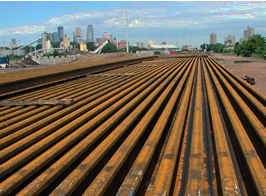 |
All rails point to downtown
Minneapolis—at least from this particular location near 28th Street and
Hwy 55/Hiawatha Avenue in Minneapolis. Photo by Jurgen Sumann
|
On Aug. 2 light rail transit marked another
milestone when neighborhood advocates and government leaders held the first
groundbreaking for an LRT station—38th Street Station—at 38th Street and Hwy
55/Hiawatha Avenue in Minneapolis.
Dignitaries on hand for the groundbreaking
included Mn/DOT Commissioner Elwyn Tinklenberg, Metropolitan Council Chairman
Ted Mondale, Minneapolis Mayor Sharon Sayles Belton, and Hennepin County Commissioner
Peter McLaughlin, along with neighborhood members of the LRT Community Advisory
Committee.
Speeches heralded the birth of modern-day
light rail transit in Minnesota, while praising the Hiawatha Avenue neighborhood’s
intensive 40-plus years of public involvement on transportation and transit
options. Groundbreaking ceremonies included three small children—offspring of
advisory committee members—carrying signs that spelled out: “L-R-T.”
“It is exciting to see and hear the sights
and sounds of construction as we build this state-of-the-art light rail transit
system,” said Tinklenberg. “Minnesotans can be proud of the Hiawatha LRT project.
It is a tribute to the positive partnerships that we have forged here. We are
doing more than investing in our transportation infrastructure; we’re investing
in our future.”
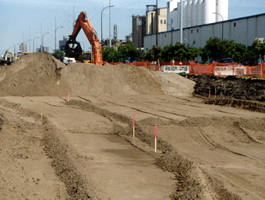 |
|
Ripples of sand will
eventually give way to the Hwy 55/Hiawatha Avenue 38th Street light rail
transit station, courtesy of construction crews running equipment such
as the digger in the distance. Photo by Craig Wilkins
|
Tinklenberg also presented a brief construction
update to the audience of 150 neighbors, agency staff members and local media.
He noted the following:
§
Construction began last January and is proceeding on schedule
for the LRT line that should begin partial operation in 2003, with full operation
in 2004.
§
In some cases—for example, rail delivery—the LRT construction
project is ahead of schedule.
§
Drilling and pouring continues this summer on five of the seventeen
transit stations, each of which will sport a completely different look designed
to reflect the uniqueness of the surrounding neighborhoods. These stations are
the Franklin, Lake Street, 46th Street and 50th Street stations, in addition
to the 38th Street station. Work will continue at these sites throughout the
rest of the year and into 2002.
§
On the northern end, near I-94 and Cedar Avenue South just south
of downtown Minneapolis, construction crews are preparing track and relocating
utility lines.
§
Metrodome visitors may notice rehabilitation work on the nearby
old railroad bridge between 11th and 15th avenues in downtown Minneapolis.
§
The Metropolitan Airports Commission will accept delivery of an
enormous tunnel-boring machine later this month. The tunnel-boring machine is
being rebuilt in Rotterdam to handle the specific type of rock underneath the
airport. It will travel by a multi-modal route: first by boat from Europe to
Lake Superior, and then by flatbed truck to the airport’s Richfield-south Minneapolis
location via I-35 and I-35W.
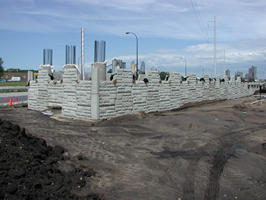 |
|
It may look like the
remains of a castle, but it’s actually the north end of the future LRT
flyover bridge over Lake Street on Hwy 55/Hiawatha Avenue in Minneapolis.
Photo by Jurgen Sumann
|
The Metropolitan Council agency, MetroTransit,
will operate the light rail line and Mn/DOT is constructing the $675 million
project. Funding comes from the Federal Transit Administration, the Minnesota
State Legislature, Metropolitan Airports Commission, Hennepin County Regional
Rail Authority and Mn/DOT.
For more information, visit Mn/DOT’s LRT site for construction
updates, station designs, news releases and photos of
construction.
|
back

|
 |
Commissioners provide vision, leadership to guide Mn/DOT through first 25 years
|
 |
 |
Editor’s note: This is the first in a series of articles Newsline will publish
looking back on Mn/DOT’s first 25 years— remembering the people, issues and
cultural forces that have shaped the agency and the milestones Mn/DOT has achieved.
Mn/DOT’s commissioners have demonstrated
a variety of leadership styles to lead the department’s evolution from a highway
department to a multi-modal agency.
While their styles differed, they all showed
a commitment to innovation and service to Minnesota, its residents and their
rapidly changing transportation needs.
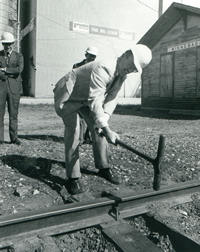 |
|
Jim Harrington served
as Mn/DOT’s first commissioner when the department was formed in November
1976. He drives a spike for a railroad improvement project in Winnebago.
|
When appointed by Gov. Wendell Anderson
as Mn/DOT’s first commissioner in 1976, Jim Harrington accepted a daunting task.
His job was to meld the former Department of Aeronautics and parts of the Department
of Public Service and the State Planning Agency into the much larger and well-established
Minnesota Department of Highways.
At that time, Mn/DOT was focused on building
the interstate highway system in Minnesota. The new department’s legislative
mandate—to create the framework for a multimodal transportation system—was clearly
going to take some doing.
Harrington assembled a management staff
that included Sherri Alston, as assistant commissioner for public transit, and
Peter Fausch, as assistant commissioner for planning and programming. Harrington’s
team also included Frank Marzitelli, the former commissioner of highways, as
assistant commissioner for operations, and Larry McCabe, the former commissioner
of aeronautics, as Mn/DOT’s assistant commissioner for aeronautics.
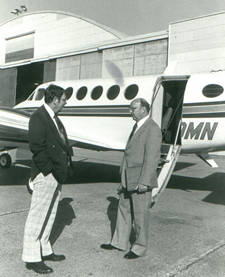 |
|
Commissioner Dick Braun
chats with Mn/DOT pilot Bill Grunau.
|
When Al Quie was elected governor in 1978,
he appointed Dick Braun to succeed Harrington. A through-the-ranks Mn/DOT engineer
and manager, Braun combined technical expertise, innate leadership and a visionary
nature to move the department to a new level of performance.
Under Braun, Mn/DOT began its full transformation
from a highway department to a multi-modal agency. The agency also entered the
period of automation that would revolutionize the way its work was done. Braun
also led Mn/DOT to prominence on at the national level by becoming president
of the American Association of State Transportation and Highway Officials. He
also catapulted Mn/DOT into national attention by championing initiatives such
as the Minnesota Road Research Project and Minnesota Rideshare, and focusing
public attention on transportation-related issues.
Braun was re-appointed as commissioner by
Gov. Rudy Perpich, testament to his credibility, professionalism and value as
a leader. Braun left Mn/DOT in 1986 to direct the newly created Center for Transportation
Studies at the University of Minnesota.
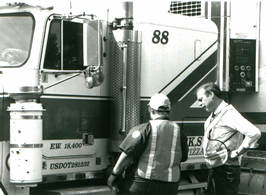 |
|
Commissioner Len Levine
takes to the field to observe a truck inspection in southeastern Minnesota
in 1989. With him is Pam DeGrote, a motor transportation representative
who now works in Duluth.
|
Perpich named Leonard Levine to succeed
Braun. Levine, a former St. Paul City Council member, combined his political
skills with Perpich’s to successfully push for an increase in the state’s fuel
tax. Their efforts resulted in raising the tax from 17 to 20 cents per gallon,
creating millions of dollars in revenue for much-needed transportation improvement
projects.
Perpich, Levine and other commissioners
took government to the people through the Capitol for a Day program. The outreach
effort created a forum where citizens and state officials could discuss their
concerns face to face.
Levine also supported initiatives such as
high-speed rail and implemented popular innovations such as the Highway Helper
program on the Twin Cities’ freeway system.
Under Levine, Mn/DOT’s sharing expertise
with other countries gained momentum, including a visit by top transportation
officials from the former Soviet Union.
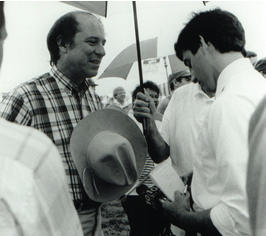 |
|
Commissioner John Riley
responds to a reporter’s questions during the annual Farm Fest. Riley
was at ease at the event—he was known for the prize-winning squash he
displayed each year at the Minnesota State Fair.
|
John Riley succeeded Levine in 1990 with
the election of Gov. Arne Carlson. An aide to former U.S. Sen. Dave Durenberger,
the bright and inventive Riley brought a fresh approach to Mn/DOT. However,
before he could begin to make his mark on the department’s operations, Riley
died of brain cancer.
Gov. Carlson then appointed Jim Denn in
1991 to succeed Riley. A former official with the Minnesota Trucking Association,
Denn brought his working knowledge of transportation’s crucial role to Mn/DOT.
Denn led Mn/DOT through the changes wrought
by ISTEA, the Intermodal Surface Transportation Efficiency Act of 1991. Among
its many innovations, ISTEA brought a new emphasis on public participation transportation
decision-making such as the Area Transportation Partnerships. The ATPs include
business leaders, local officials and others who set priorities for transportation
projects.
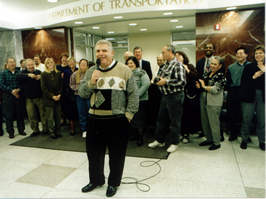 |
|
In January 1999, Commissioner
Jim Denn bids farewell to Mn/DOT during an impromptu gathering at the
Transportation Building in St. Paul on his last day as commissioner.
|
The decentralized decision-making also suited
Denn’s style and values. During Denn’s seven-year term, for example, Mn/DOT
partnered with cities and counties to build joint maintenance facilities at
Hutchinson and Hibbing.
Denn’s administration also instituted a
market research program to determine who the department’s customers are, what
their expectations are and how well Mn/DOT meets them.
Denn’s term was also marked by an emphasis
on increasing diversity in the ranks of Mn/DOT employees. Mn/DOT created its
Seeds program and initiated other outreach programs such as TRAC and actively
recruited graduate engineers who are women or people of color.
Denn’s low-key style and respectful nature
earned him widespread affection among employees. When he left office in January
1999, Denn was greeted by hundreds of Central Office employees who spontaneously
gathered to say goodbye and wish him well in the future.
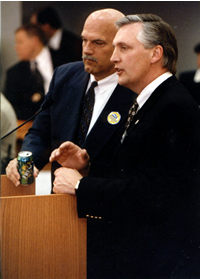 |
|
Commissioner Elwyn Tinklenberg,
right, with Gov. Jesse Ventura, introduce the Moving Minnesota package
to the 2000 Legislature. Photo by Kevin Walker
|
The election of Gov. Jesse Ventura in 1998
brought the appointment of Mn/DOT’s current commissioner, Elwyn Tinklenberg.
With strong backing from the governor, Tinklenberg re-energized Mn/DOT’s commitment
to multi-modal transportation and envisioned the long-range strategy to improve
the state’s transportation: Moving Minnesota.
Their efforts resulted, for example, in
a one-time allocation of $459 million by the 2000 Legislature to support the
Moving Minnesota effort.
Tinklenberg’s vision rests on four strategic
objectives: increasing travel options for moving people and goods; ensuring
that corridors of statewide significance link regional trade centers; streamlining
the highway construction and maintenance program delivery; and providing timely
and accurate information for Mn/DOT’s customers.
Reviewing 25 years of Mn/DOT history during
a celebration held July 30, Tinklenberg said since Mn/DOT’s first commissioner
was appointed in 1976, Minnesota has evolved quickly as an economic hub for
a multi-state region and become more fully part of the global economy.
Mn/DOT, he said, needs to continue its leadership
in finding ways to do things faster and better, continue management innovations,
and forge partnerships with cities, counties, consultants and contractors.
“While the challenges ahead are great,”
he said, “Mn/DOT, as a great organization, will respond to them the way it always
has—creatively, professionally and boldly.”
By Craig Wilkins
|
back

|
 |
Minnesota hosts first national forum on TEA-21 reauthorization
|
 |
 |
Transportation experts, policy makers, lawmakers and students in Minnesota
paved the way this week for what is expected to be a national series of listening
sessions on the reauthorization of the Transportation Equity Act for the 21st
Century—the federal legislation that outlines funding for transportation across
the country.
Commissioner Elwyn Tinklenberg served as moderator for the first forum, held
Aug. 7 at the Hubert H. Humphrey Institute of Public Affairs in Minneapolis.
The sessions are designed to gather input for the upcoming reauthorization of
TEA-21 by Congress in 2003. Organizers said the first listening session went
well and will serve as a model for future forums that will be scheduled around
the country.
Distinguished panel
In addition to Tinklenberg, speakers included the Federal Highway Administration’s
Cynthia Burbank; Sean O’Hollaren, assistant secretary for the U.S. Department
of Transportation; U.S. Rep. James Oberstar; U.S. Rep. Martin Olav Sabo; state
Sen. Julie Sabo; state Sen. Roy Terwilliger; and Met Council Chairman Ted Mondale.
Minnesota considered a leader
The topic of the session was transportation and the environment. Organizers
say the FHWA selected Minnesota to host the forum because of its leadership
in considering the environmental impact of transportation. Burbank said Minnesota
has won more FHWA environmental awards than any other state.
"While many people think transportation and concern for the environment are
opposing ideas, in fact, they go together,” Commissioner Tinklenberg noted.
“Mn/DOT’s strategy of Moving Minnesota is consistent with environmental protection.
It increases transportation choices, encourages mass transit and works with
communities to improve efficiency on interregional corridors. All of these protect
the environment and reduce pollution by reducing highway congestion.”
Interactive
Wireless voting technology used at the session enabled the audience to weigh
in with their opinions on a series of 40 questions. One that stimulated discussion
asked audience members what they thought is the most important initiative for
Minnesota in federal legislation. A majority answered: more funding to better
balance the modes of transportation. But when asked how they thought most Minnesotans
would vote, a majority answered: reduce congestion. The questions and answers
are expected to be available by early September on the HHH Institute of Public Affairs Web
site.
By Pat Lund
|
back

|
 |
Freight advisory committee holds transportation dialogue
|
 |
 |
Mn/DOT’s Freight Advisory Committee, in partnership with
the Center for Transportation Studies, hosted a freight transportation dialogue
luncheon at the Radisson Metrodome Aug. 7.
Guest speakers included U.S. Rep. James
Oberstar; Sean B. O’Hollaren, assistant secretary for governmental affairs for
the U.S. Department of Transportation; and Commissioner Elwyn Tinklenberg.
In their remarks, Tinklenberg and Oberstar
called on the U.S. DOT to take a primary leadership role to ensure freight concerns
are addressed as part of the reauthorization of the Transportation Equity Act
for the 21st Century. They added that others who rely on the movement of freight
should also become actively involved in the discussion. Both Tinklenberg and
Oberstar acknowledged the importance of transportation to the future economic
vitality of the state and the region.
Tinklenberg said he would announce at an
event planned for December a series of freight initiatives to be undertaken
by Mn/DOT.
|
back

|
 |
Rumble strips keep drivers on course for fewer crashes
|
 |
 |
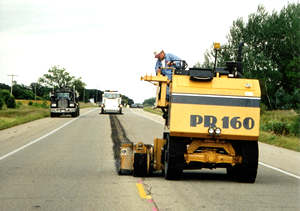 |
A few miles down, but
many more to go: This contractor employee monitors the early stages of
creating centerline rumble strips on Hwy 23 west of Spicer. Photo
by Sandy East
|
Straying ‘off course’ while driving can be quite serious, especially on a
hilly, winding two-lane highway. But bumpy, ‘coarse’ rumble strips installed
in the highway centerline might jar drivers from wandering over the centerline
and prevent another kind of ‘bump’—traffic crashes.
That, at least, is the principle behind 50 miles of rumble strips installed
last year in the median of the highly congested, two-lane Hwy 23 between Willmar
and St. Cloud. Three focus groups in both areas recently told Mn/DOT market
researcher Lee Brady that they believe that these strips are working.
“Nearly all of the drivers in our focus groups are convinced
that the rumble strips have saved lives, including their own,” Brady said. “They
reported feeling more safe as a result, and none of them could remember hearing
of a fatality since the rumble strips were installed.”
Reducing fatalities is a primary goal of this project, and
“the first year suggests that we’re on the right track,” according to District
3 traffic engineer Gary Dirlam and assistant
District 3 traffic engineer Tom Dumont. In recent years, Hwy 23 traffic has
increased to about 10,000 vehicles/day with a mixture of age groups, travel
purposes and driving speeds—and a potential for increases in traffic crashes.
(By comparison, traffic near Paynesville nearly tripled from
2,650 vehicles a day in 1981 to 6,100 in 2000, while traffic on Hwy 23 from
Rockville to I-94 doubled for the same period: from 6,800 in 1981 to 15,400
vehicles a day in 2000.
Before installing centerline rumble strips, Dumont said,
“There were five fatal crashes in one four-week period; three of the five fatals
involved vehicles crossing the centerline during good weather. All of the fatal
crashes involved young to middle-aged people.”
Focus group members “haven’t heard of any fatalities since
the rumble strips,” and believe that the experiment is working so far, according
to Brady. However, Dirlam said, “It’s too soon to tell.”
“We’re moving in the right direction, but we can’t say for
at least three years whether or not this is a trend,” Dirlam added. “We will
continue to monitor traffic volumes and crashes for awhile, along with customer
feedback. California also installed rumble strips in the medians in 1997, and
we’re trying to get their before-and-after study. From looking at 16 years of
crashes history, I believe six-year time frames give better trend lines
for fatal crashes.”
Although most focus group members felt safer, emergency vehicle
operators and State Patrol troopers reported some problems in high-speed conditions.
These drivers said they had, however, adjusted their driving techniques to avoid
further problems.
Maintenance workers in Districts 3 and 8 met separately with
Dirlam and Brady to report some problems with snow and ice removal and suggested
modifications to the rumble strips that could help plowing practices.
Dirlam said that the districts are also considering other
congestion-relief and safety-improvement changes. A corridor study is underway;
District 3 has completed an environmental impact statement for a divided four-lane
facility from I-94 to Richmond;
and District 8 is pursuing a Paynesville bypass and a four-lane divided
highway between Willmar and Spicer.
District 8 public affairs coordinator Sandy East initiated
the market research study, which is the first of its kind in the state, Dirlam
said.
“Other areas of the state also have the centerline rumble
strips, but, now we know how people think of them,” he added. “We would not
have heard of certain difficulties if not for the market research.”
|
back

|
 |
Hot enough to fry an egg?
|
 |
 |
Thanks to a high-tech monitoring system,
MnDOT knows the answer to that question.
Mn/DOT’s road weather information system
consists of 93 sites throughout the state that collect data from atmospheric
and pavement sensors and transmit this information to servers in St. Paul, which
use the Internet to deliver information to Mn/DOT staff and others.
The $4 million system primarily is used
to monitor winter road conditions to aid in more efficient use of chemicals
and equipment, according to Curt Pape, RWIS coordinator.
The pavement sensors are contained in a
round epoxy coating and resemble a large hockey puck. Installed around the state,
the sensors work around the clock measuring pavement temperature and surface
conditions, Pape said.
Although snow and ice control are the bread
and butter of RWIS, the system has proven useful year around. RWIS can be used
to generate records required in herbicide spraying, determine conditions at
remote sites and monitor road temperatures in very hot weather. Since the information
generated by this system is stored in a database, Mn/DOT will be able to study
the data in the future to better predict things such as pavement failures and
other temperature-related problems, Pape said.
The concept for RWIS originated in Europe
and has now been adopted by several state transportation departments. Although
Mn/DOT has been experimenting with this technology since the mid-1980s, it was
fully implemented for the first time last winter, Pape said.
“It is exciting to be involved in something
that should not only save money but make Mn/DOT more efficient in meeting the
public’s needs,” he added.
Testing and adopting new technology such
as RWIS is one way MnDOT has become established as an international leader in
transportation. This month a Russian delegation had a look at the system. In
the past few months, visitors from Norway, Sweden, Japan and China have also
checked it out.
As for the question: Is it hot enough to
fry an egg?
No, the temperature of a frying pan must
reach about 300 degrees to cook an egg. The hottest spot on Minnesota roads
so far this summer is a toss up with several sites reporting 138 degrees on
Tuesday, Aug. 7.
By Pat Lund
|
back

|
 |
Work zone fatalities reach record high nationally
|
 |
 |
You’ve seen the recent statistics—and they’re
not pretty.
According to the National Highway Traffic
Safety Administration, a record number of people—872—were killed in work zones
in 1999. In addition, the nation recorded an annual average of 39,000 people
injured in work zones during the late 1990s.
Locally, the Department of Public Safety
reports that there were 2,397 work zone crashes in Minnesota last year, resulting
in 11 deaths and more than 1,000 injuries.
“At any given time during the construction
season in Minnesota, there are at least 175 ongoing construction projects,”
said Mary Meinert, work zone safety coordinator. “Along with this are the many
local and municipal road projects, bringing Minnesota’s road construction projects
to about 300 at any given point during the season.”
That’s why Mn/DOT is committed to educating
drivers and construction workers about safety in work zones, Meinert said.
Last year, the Office of Construction and
Maintenance, in partnership with the Office of Traffic and Metro Maintenance,
completed an extensive field training for signing and flagging of construction
projects. More than 3,000 workers (1,600 from Mn/DOT and 1,200 from the private
sector) went through training for personal, equipment and project staging safety,
according to Bill Servatius, construction programs coordinator.
Mn/DOT also partnered with the Minnesota
State Patrol and St. Cloud State’s Highway Safety Center to train drivers of
large construction vehicles (private contractors) about vehicle and roadway
safety, according to Dennis Creen, Motor Carrier Services. About 650 drivers
and company safety directors participated this year.
“Mn/DOT ‘strongly encourages’ participation
in these trainings,” Servatius said. “This is a strong message to the industry:
we want our projects to be safe—for everyone.”
The department also supports a work zone
safety speaker’s bureau. Each district sends speakers to schools, driver’s education
classes and community groups to spread Mn/DOT’s safety messages. More than 12,000
individuals benefited from these outreach efforts last year, Servatius said.
New this summer are the billboards and bus
kings with the most recent work zone safety campaign. This was designed as a
“pay attention or someone dies” work zone message, Meinert said. This campaign,
in partnership with the State Patrol, focuses on Trooper Ted Foss, who was killed
in the work zone last summer.
Marketing research done by Mn/DOT indicates that most drivers
in work zones are not concerned for their own safety, Meinert said. Their greater
fear is hitting a worker.
“Drivers in work zones need to be reminded
that by watching out for workers, they are watching out for themselves—and they
are at greater risk than the workers, as the numbers indicate,” Meinert said.
For more information about national highway traffic safety,
visit the NHTSA Web site.
|
back

|
|
 |
|
|


